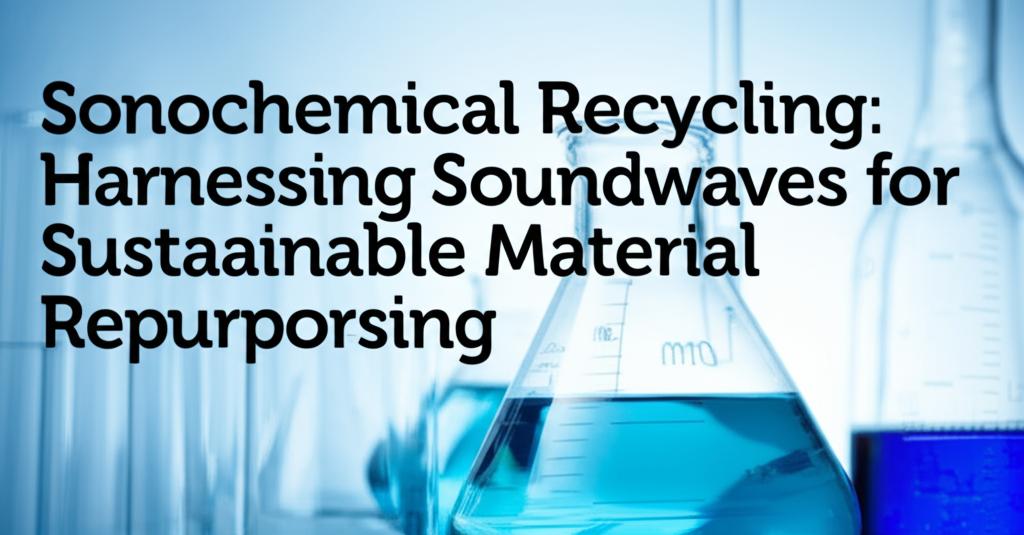The world is increasingly focusing on sustainability and the circular economy, and innovative methods for recycling and repurposing materials are in high demand. Sonochemical recycling, which uses high-frequency soundwaves, is emerging as a promising green technology. This method offers an environmentally friendly way to break down complex materials and recover valuable components.
How Sonochemistry Works in RecyclingSonochemistry harnesses a phenomenon called acoustic cavitation. When liquids are irradiated with high-intensity ultrasound waves (typically above 20 kHz), tiny bubbles form, grow, and violently collapse. This implosion creates localized hotspots with extremely high temperatures and pressures, along with powerful shockwaves and microjets. These intense physical and chemical effects can:
- Break down complex materials: The mechanical forces generated by cavitation can physically disrupt the structure of materials, breaking apart polymers or separating different components of a composite material.
- Enhance chemical reactions: The extreme conditions within the collapsing bubbles can accelerate chemical reactions involved in material degradation or transformation. This can include breaking chemical bonds within polymers or facilitating the leaching of valuable metals.
- Improve mass transfer: The micro-mixing caused by cavitation enhances the contact between reactants, such as solvents and the material being recycled, making processes more efficient.
Sonochemical recycling is showing significant potential across various applications:
- Plastics Repurposing: Sonication is being explored to degrade polymers like polypropylene (PP), low-density polyethylene (LDPE), and polyethylene terephthalate (PET). For PET, often found in beverage bottles, ultrasonic treatment can assist enzymatic degradation processes, potentially breaking down the plastic into its original monomers for high-quality recycling. This method can overcome the limitations of traditional recycling that often result in lower-quality plastics. Research has shown that ultrasound can rupture polymer chains without needing harsh solvents or additives, and can even improve the morphology of polymer blends.
- Fuel Cell and Battery Recycling: A major breakthrough involves using ultrasound to recycle components of fuel cells and lithium-ion batteries.
Fuel Cells: Researchers have developed a scalable method using organic solvent soaking followed by water ultrasonication to separate valuable platinum group metals and "forever chemicals" (PFAS membranes) from catalyst-coated membranes (CCMs) in fuel cells. A continuous delamination process using a bespoke blade sonotrode that employs high-frequency ultrasound can separate these materials in seconds at room temperature, offering a sustainable and economically viable recycling route.
Batteries: Ultrasonic delamination allows for the rapid recovery of active materials like lithium, nickel, manganese, and cobalt from battery electrodes. This process is significantly faster and more energy-efficient than conventional hydrometallurgical and pyrometallurgical methods, and can yield materials of higher purity. Ultrasonic leaching also improves the extraction of these valuable metals, making urban mining of electronic waste more feasible.
- Composite Material Recycling: Carbon Fiber Reinforced Polymers (CFRPs) are notoriously difficult to recycle. Sonochemical approaches, sometimes combined with mild acids and peroxides, can enhance the decomposition of the resin matrix, allowing for the recovery of carbon fibers with minimal damage. Research has shown this method can achieve high resin decomposition rates, yielding recovered fibers with tensile strength comparable to virgin fibers.
- Nanomaterial Synthesis and Modification: Sonochemistry is not only used for breaking down materials but also for synthesizing nanoporous materials and nanostructured materials with unique properties. This includes creating metal oxides, activated carbons, and metal-organic frameworks (MOFs) that can be used in applications like gas adsorption, water treatment, and catalysis. Ultrasound can influence particle size, shape, and porosity, leading to materials with enhanced performance. For instance, sonochemically synthesized magnetic nanoparticles have shown improved heating efficiency for applications like magnetic fluid hyperthermia.
- Sustainability and Environmental Friendliness: Sonochemical methods often require less energy, operate at lower temperatures, and can reduce the need for harsh or toxic chemicals and solvents compared to traditional recycling techniques. This aligns with the principles of green chemistry.
- Efficiency and Speed: Ultrasound can significantly accelerate reaction times. For example, delamination of fuel cell components can occur in seconds, and ultrasonic delamination of battery electrodes can be much faster than conventional methods.
- Enhanced Material Recovery and Purity: Sonication can lead to higher recovery rates of valuable materials and often results in products of greater purity.
- Versatility: The technology shows promise for a wide range of materials, including various plastics, composites, and electronic waste.
- Scalability: Researchers are actively working on scaling up sonochemical processes for industrial application.
Despite its many advantages, some challenges remain in the widespread adoption of sonochemical recycling:
- Understanding Mechanisms: A deeper understanding of the complex mechanisms involved in sonochemical processes for different materials is needed to optimize and control outcomes.
- Scale-Up and Cost-Effectiveness: While promising at the lab scale, scaling these technologies to industrial levels while maintaining cost-effectiveness is a key hurdle. This includes optimizing reactor design and energy consumption.
- Material Specificity: The effectiveness of sonochemical treatment can vary significantly depending on the material's properties, requiring tailored approaches.
- Fragment Management: For some polymer degradation processes, the result might be smaller oligomers rather than pure monomers, which still poses questions for reuse and complete circularity.
Nevertheless, the ongoing research and recent breakthroughs signal a bright future for sonochemical recycling. As the demand for sustainable solutions grows, harnessing the power of soundwaves offers a powerful and innovative pathway to repurpose materials, reduce waste, and move towards a more circular economy. The ability to recover valuable resources efficiently and with a lower environmental footprint makes sonochemistry a critical technology to watch in the evolving landscape of material sustainability.

